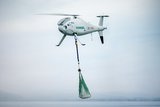Northrop Grumman's Fire Scout Vertical unmanned system rises to the test under extreme environmental conditions
The US Navy and the Northrop Grumman Corporation-led Fire Scout Industry Team have successfully completed a rigorous set of flight demonstrations of the MQ-8B Fire Scout vertical unmanned aerial system (VUAS) in the United Arab Emirates under extreme environmental conditions.
The Fire Scout Industry Team includes Sikorsky/Schweizer Aircraft, Rolls-Royce, Raytheon, FLIR Systems, Cubic, Kearfott, Rockwell-Collins, General Electric, Sierra Nevada, Telephonics, and L-3 Communications.
The desert test flights were conducted over a ten-day period in early July. They validated the steady maturation of the Fire Scout system and added confidence to its readiness for the Navy's upcoming Operational Evaluation of the system, planned for late 2010 aboard the USS Halyburton (FFG-40).
The exercises included numerous takeoffs and landings in hot, windy and sandy conditions in temperatures as high as 50 degrees Celsius (122 degree Fahrenheit). The VUAS also conducted various test flights at altitudes up to 3,000 meters (9,842 feet)
The Fire Scout mission demonstrations included non-line-of-sight operations that showcased the VUAS' ability to operate autonomously in remote locations; and its FLIR Systems electro-optical/infrared (EO/IR) sensing capabilities, which are used to locate and acquire targets.
The field trials also demonstrated Fire Scout's ability to gather and transmit high fidelity video imagery, a capability vital to the intelligence, surveillance, reconnaissance and target acquisition missions it performs for military services.
Quotes:
"We welcome Northrop Grumman and the US Navy to the UAE for continued testing of the Fire Scout. This VUAS has many unique capabilities to offer and we're looking forward to reviewing the results of this in-country testing." - Ali Al Yafei, ADASI (Abu Dhabi Autonomous Systems Investment).
"Today's demonstration was very impressive and reinforces the continued maturation of the Fire Scout system and its capabilities. Northrop Grumman thanks the UAE for being such a gracious host and offering us the opportunity to test Fire Scout in the extreme heat of summer." - John Brooks, president, Northrop Grumman International Inc.
"The UAE represents an important partnership for Northrop Grumman and our customers in the Gulf Cooperation Council demand the best. We are committed to continuing to meet and exceed their expectations." - John Brooks, president, Northrop Grumman International Inc.
"The capabilities that Fire Scout delivers to warfighters really stood out today. The demonstration proved that the air vehicle and its sensors can do exactly what they're designed to do: extend the range at which we can gather crucial information during peacekeeping or wartime missions." - Duke Dufresne, sector vice president and general manager, Strike and Surveillance Systems Division, Northrop Grumman Aerospace Systems.
Boilerplate about Fire Scout:
The Northrop Grumman-built MQ-8B Fire Scout Vertical Unmanned Aerial System (VUAS) is an autonomous, unmanned helicopter currently under development with the US Navy. Based on an FAA-certified Schweizer Aircraft commercial airframe with more than 20 million flight hours, it is the only US Department of Defense VUAS program of record.
Fire Scout features a modular architecture that accommodates a variety of electro-optical/infrared (EO/IR) and communications payloads. These payloads provide ground and ship-based commanders with high levels of situational awareness and precision targeting support during missions lasting up to seven hours. The Navy has also identified radar as a firm requirement for Fire Scout, which will give it a wide area search capability.
Fire Scout is designed to take off and land autonomously on any aviation-capable warship, and at prepared and unprepared landing zones in proximity to ground troops. It is also fully interoperable between land and sea-based tactical control systems.
Fire Scout's ability to operate at low ground speeds makes it particularly well suited for supporting littoral missions such as drug interdiction, search and rescue, reconnaissance and port security. It can also acquire and track targets in complex and urban terrain.
Source: Northrop Grumman
More from Uncrewed Vehicles
-
Jammer resistant drone designs spark search for countermeasures
The Russia-Ukraine conflict has driven another stage of evolution for drones and the counter measures to defend against them.
-
![L3Harris launches Amorphous software for control of uncrewed platforms]()
L3Harris launches Amorphous software for control of uncrewed platforms
The new Amorphous software is a universal controller that would allow a single operator to control a swarm of “thousands” of uncrewed systems, from drones to underwater platforms.
-
ideaForge unveils new UAVs at Aero India 2025
India UAV supplier ideaForge has launched the Netra 5 and Switch V2 drones at Aero India 2025, boasting of enhanced endurance, AI-driven autonomy and improved operational capabilities.
-
![Shaping the future of defence: What 2025 holds for the global drone market]()
Shaping the future of defence: What 2025 holds for the global drone market
The UAV market is experiencing unprecedented growth, with innovations in technology and battlefield applications driving demand across military sectors. From the battlefields of Ukraine to NATO exercises and beyond, drones are transforming how wars are fought and supported.
-
![Maris-Tech confirms customers signing up for Jupiter Drones codec and AI-powered system]()
Maris-Tech confirms customers signing up for Jupiter Drones codec and AI-powered system
Launched at AUSA in October, the company’s multi-stream video codec is attempting to bring a new lease of life to drone technology through its AI accelerator.
-
![AUSA 2024: Quantum-Systems targets big 2025 with UAS developments]()
AUSA 2024: Quantum-Systems targets big 2025 with UAS developments
Quantum-Systems has been upgrading its UAS family, with new versions of the Vector, Reliant and Twister drones set for release throughout 2025.
























